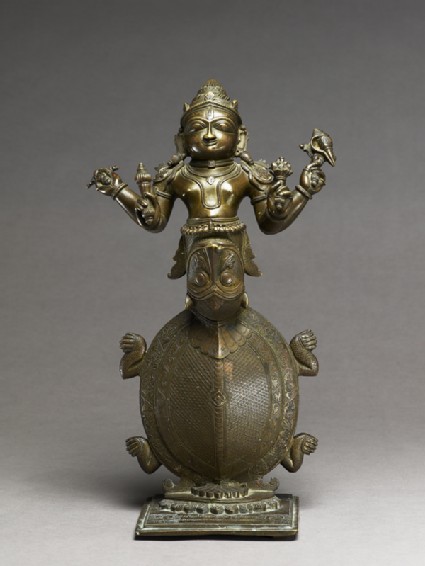Browse: 341 objects
- Reference URL
Actions
Figure of Kurma, the Tortoise incarnation of Vishnu
-
Details
- Associated place
-
Asia › India › west India › Gujarat (possible place of creation)Asia › India › west India › Maharashtra › Mumbai (possible place of creation)
- Date
- 1801 (Samvat 1858)
- Material and technique
- bronze, solid cast
- Dimensions
- 39 x 22 x 13.5 cm max. (height x width x depth)
- Material index
-
processed material › metal › alloy › copper alloy › bronze
- Technique index
- Object type index
- No. of items
- 1
- Credit line
- Purchased, 1967.
- Accession no.
- EA1967.43
-
Further reading
Harle, J. C., and Andrew Topsfield, Indian Art in the Ashmolean Museum (Oxford: Ashmolean Museum, 1987), no. 61 on p. 50, illus. p. 50
Glossary
Vishnu
-
Vishnu
Vishnu is, with Shiva, one of the two most important gods in later Hinduism. He is regarded as sustainer of the universe and maintainer of order. Assuming various forms (avatars), he restores the balance of good and evil in the world.
Location
Objects are sometimes moved to a different location. Our object location data is usually updated on a monthly basis. Contact the Jameel Study Centre if you are planning to visit the museum to see a particular object on display, or would like to arrange an appointment to see an object in our reserve collections.
Galleries
Publications online
-

Indian Art in the Ashmolean Museum
Viṣṇu’s second avatāra, when he served as the pivot or support for the churning stick when the gods and the asuras, using the serpent Vāsuki as a rope, churned the ocean of milk. This is one of the principal Indian creation myths. Viṣṇu is usually represented, as here, with a human upper body. He holds his usual attributes, the cakra, or discus (here bent back), the conch-shell, the club and the lotus.
There is a short two line inscription in Sanskrit on the base, which reads:
// Śrī Kūrmasevakaś Cedipatiḥ Kūrmapālaḥ // Jaiṣṭaśukla // 8 // Saṃ // 1858 (?) // muḥkāsī // (sic.)
The final word of the inscription is obscure.
© 2013 University of Oxford - Ashmolean Museum













